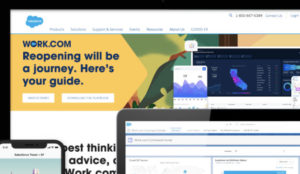One of the many disappointments we’ve seen in handling the COVID-19 crisis has been how cloud software companies have been almost shut out of participating in providing solutions. In some ways it’s to be expected because databases and wet chemistry aren’t a natural fit, but still…
Early in the crisis vendors like Salesforce and Zoho began offering their products for free, or at low cost, to companies and end users suddenly faced with working at home. Oracle, Salesforce and others also developed tracking apps that could be easily deployed on the Web to help health authorities track exposure and quarantines.
Some states were more aggressive in trying to apply technology. For example, Rhode Island, whose governor Gina Raimondo is a former venture capitalist and is currently being vetted by the Senate to be the next Secretary of Commerce. Raimondo engaged with Salesforce early on to get an exposure tracking app built that has been used in numerous other states.
But the apparent disinterest and even outright hostility aimed at public health initiatives in some states relegated tracking to the back of the bus. The only issue driving interest in many quarters has been finding a vaccine. That’s too bad because silver bullets don’t often solve problems, though they can help a lot. By their natures complex problems are best handled by a portfolio of solutions that lead to the desired result.
It’s not a question of vaccine or, but of vaccine and; as in vaccine and masks and hand hygiene and public health such as spacing and therapeutics. We know this but we’ve been eagerly awaiting a vaccine while dismissing the other parts of the portfolio with predictable results. But the portfolio is exactly where software solutions for tracking and tracing to support public health can do the most good. The public just seems to not have the interest.
Problem Solvers
Nevertheless, if you step back and look at what the tech sector has demonstrated to us through COVID, you can feel impressed. There are multiple huge networks capable of bringing technical solutions to any corner of a reasonably mature society i.e., one with good Internet support, which Oracle and others have shown.
There are also multiple application development environments capable of delivering management solutions with very little notice. They don’t deliver vaccines, but we’ve seen how ineffective vaccines alone are.
Look at Salesforce’s efforts over the pandemic: The company upended its development calendar about a year ago to develop and bring to market solutions that could make the pandemic a little less awful.
Salesforce Anywhere supports cubical workers trying to do their jobs at home, and Work.com offers apps that help organizations to do things we never thought of before, like staggering employee arrival times to minimize traffic on elevators where viral spread could happen.
Oracle recently announced a partnership with the Malaysian drug company Pharmaniaga Bhd to use the cloud-based logistics platform — Oracle Fusion Cloud Supply Chain and Manufacturing (SCM) — to improve logistics for vaccine distribution.
Salesforce also recently announced Vaccine Cloud, which is designed to support vaccine management, the stuff that happens once the vaccine is in vials and ready to ship. You can find out more here.
The most important thing from my perspective is that the product provides the structure for small organizations to effectively manage their time, labor and supplies to optimize getting shots into arms.
As a CRM issue, once again we have an example of how the platform is driving business performance. Flexible software drives business agility, I like to say, and nothing drives software flexibility like a development environment that generates code to support multiple systems. Integration, analytics, workflow and other aspects of running applications all converge into a development environment with a code generator.
Answering the Call
Vendors have always looked for proof of concepts that tell a bigger story than a simple use case because they help sell product. In the releases and announcements we’re seeing in the CRM world, we’re seeing more.
The cloud and cloud-based platforms are not perfect, but we’re light years ahead of where we were just a few years ago when, too often, if our businesses were presented with even routine challenges our almost default answer was “Our system won’t let us do that.”
In stark contrast, according to a video of Gina Raimondo that I saw at Dreamforce a few months ago, when the governor called Marc Benioff early last year looking for help with tracking and tracing, Benioff’s response was, “Okay, I’ll have somebody there on Monday.”
This approach to responsive technology isn’t a result of the pandemic, we’ve been on this path for twenty years, but the crisis has served to demonstrate the solution; and for the broader civilization I think it marks an important turning point, maybe like moveable type.




























































